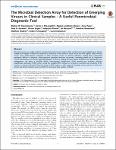The Microbial Detection Array for Detection of Emerging Viruses in Clinical Samples - A Useful Panmicrobial Diagnostic Tool
Rosenstierne, Maiken W.
McLoughlin, Kevin S.
Olesen, Majken Lindholm
Papa, Anna
Gardner, Shea N.
Engler, Olivier
Plumet, Sebastien
Mirazimi, Ali
Weidmann, Manfred
Niedrig, Matthias
Fomsgaard, Anders
Erlandsson, Lena
Emerging viruses are usually endemic to tropical and sub-tropical regions of the world, but increased global travel, climate change and changes in lifestyle are believed to contribute to the spread of these viruses into new regions. Many of these viruses cause similar disease symptoms as other emerging viruses or common infections, making these unexpected pathogens difficult to diagnose. Broad-spectrum pathogen detection microarrays containing probes for all sequenced viruses and bacteria can provide rapid identification of viruses, guiding decisions about treatment and appropriate case management. We report a modified Whole Transcriptome Amplification (WTA) method that increases unbiased amplification, particular of RNA viruses. Using this modified WTA method, we tested the specificity and sensitivity of the Lawrence Livermore Microbial Detection Array (LLMDA) against a wide range of emerging viruses present in both non-clinical and clinical samples using two different microarray data analysis methods.
Dateien zu dieser Publikation
Keine Lizenzangabe
Verwandte Publikationen
Anzeige der Publikationen mit ähnlichem Titel, Autor, Urheber und Thema.
-
2000-10-01ZeitschriftenartikelLebensmittelassoziierte Virusinfektionen Höhne, Marina; Schreier, EckartBis in die 70er Jahre war die Diagnostik von infektiösen Diarrhöen auf den Nachweis von Bakterien und Parasiten beschränkt, und auslösende Erreger konnten nur in einigen Fällen ermittelt werden. Verbesserte Nachweismethoden ...
-
2015-06-19ZeitschriftenartikelIn Silico Prediction and Experimental Confirmation of HA Residues Conferring Enhanced Human Receptor Specificity of H5N1 Influenza A Viruses Schmier, Sonja; Mostafa, Ahmed; Haarmann, Thomas; Bannert, Norbert; Ziebuhr, John; Veljkovic, Veljko; Dietrich, Ursula; Pleschka, StephanNewly emerging influenza A viruses (IAV) pose a major threat to human health by causing seasonal epidemics and/or pandemics, the latter often facilitated by the lack of pre-existing immunity in the general population. Early ...
-
2015-11-10ZeitschriftenartikelComparison of the Cowpox Virus and Vaccinia Virus Mature Virion Proteome: Analysis of the Species- and Strain-Specific Proteome Döllinger, Jörg; Schaade, Lars; Nitsche, AndreasCowpox virus (CPXV) causes most zoonotic orthopoxvirus (OPV) infections in Europe and Northern as well as Central Asia. The virus has the broadest host range of OPV and is transmitted to humans from rodents and other wild ...

